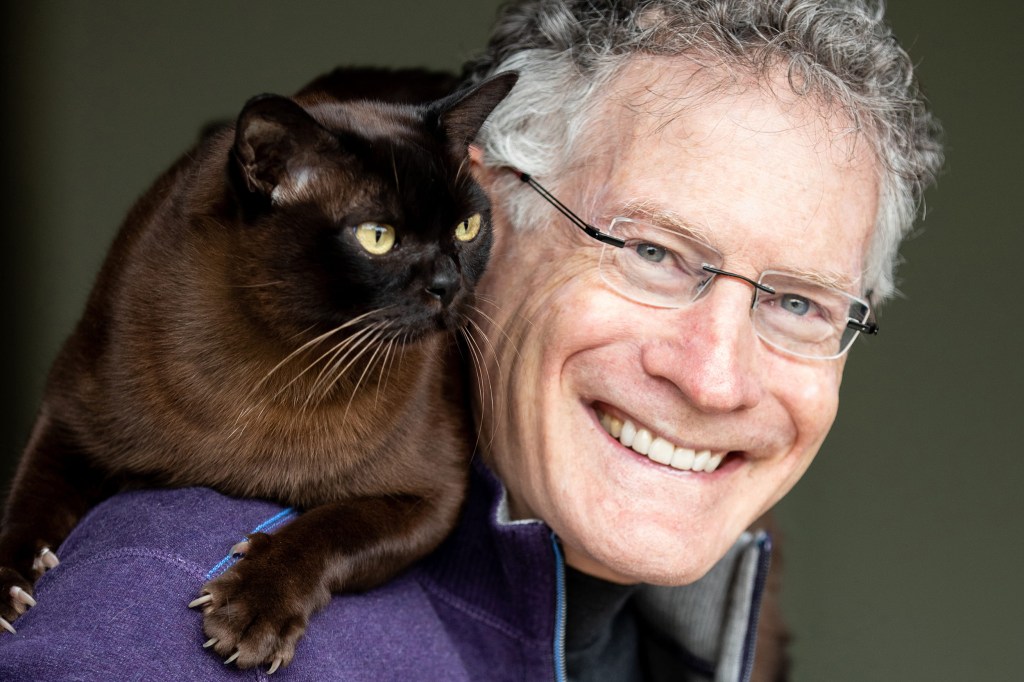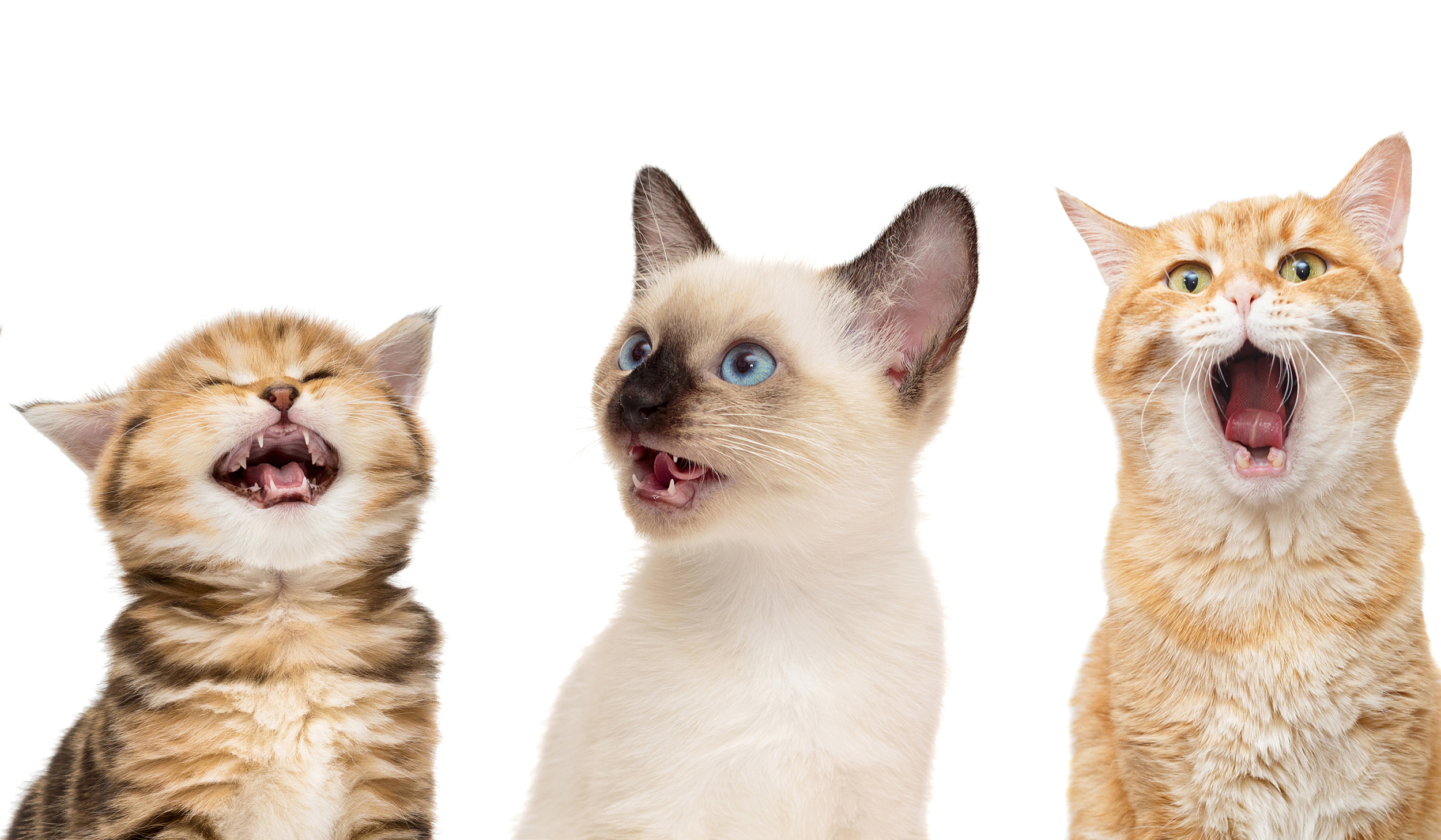Cats meow at each other. So Jonathan Losos always viewed a cat meowing to him as a kind of compliment. It was as if he was being saluted as a peer.
Not so, it turns out. Rather, it’s all the better to manipulate you, my dear.
Evolutionary biologist Losos ’84, a former Harvard faculty member, entertained a feline-loving crowd at the Geological Lecture Hall last Saturday. Talking about his new book, “The Cat’s Meow: How Cats Evolved from the Savanna to Your Sofa,” the William H. Danforth Distinguished University Professor in Arts & Sciences at Washington University in St. Louis mixed research with stories about his own pets.
Losos pointed out this book, and the science behind it, is a bit of a departure for him. Despite a childhood love of cats, Losos became an eminent herpetologist, largely from a desire to study lizards, another childhood passion, and one that could be more easily observed in its natural state.
“I was also under the impression that there was no interesting research on domestic cats,” said Losos, who was nattily clad in a shirt adorned with black cats. “I was wrong.”
While researching a first-year seminar on cats (which he correctly predicted would be popular), he connected with a number of researchers and ongoing studies. One was on the meow.
The work proved his belief about meowing wrong — and more. While all species of small wild cats, such as cervals and ocelots, vocalize at each other, and some larger ones, such as cheetahs, do too, he shared research that shows how the signature sound of the “meow” has evolved.
Cornell University graduate student Nicholas Nicastro had recorded large cat vocalizations at the Pretoria Zoo in South Africa and compared them with the mews of ordinary house cats. The wild cats’ meow, Losos explained, “comes across as much more urgent and demanding. The domestic cat is much more pleasant to our ears, higher pitched. What that suggests is that during domestication cats evolved a difference in their meow that is more appealing to us — and lets them manipulate us more.”
“When cats live in high-density areas,” such as urban cat colonies, fishing villages, or farms, “they behave like lions.”

Jonathan Losos.
Credit: Lynn Werner-Marsden Photography
A similar change was observed in purrs. While all small species of wild cat also purr, domestic cats have distinct “contentment” and “solicitation” purrs. The solicitation purr, he noted, reaches higher pitches, similar to the cry of a human baby, which we innately relate to.
Losos also covered how cats communicate with each other. A raised tail, for example, appears to signal that a cat is friendly and approachable. Studies using silhouettes of cats with tails raised and tails down appear to confirm this.
And while the studies only worked for a limited time — the cats quickly learned the silhouettes weren’t other cats — they did respond at first. If the silhouette had its tail up, “they stick up their own tails and approach. Tail down and the cats approach much less quickly, and they didn’t raise their own tails.”
While this is seen as a trait that evolved with the domestication of cats, it isn’t unprecedented: Lions, which live in social groups, also signal approachability and amiability with raised tails.
Lion social groups, or prides, consist of related females who will groom each other, hunt together, and even nurse each other’s cubs, he went on to explain. Domestic cats can also be highly social, especially with other felines with which they have been raised. “When cats live in high-density areas,” such as urban cat colonies, fishing villages, or farms, “they behave like lions.”
The one major difference? “Lions hunt collectively and can bring down much larger prey this way. Fortunately, domestic cats don’t do this.”
The evolutionary biologist then moved on to how our house cats came to be, tracing domestic cats from the earliest feline, proailurus lemanensis, some 30 million years ago, up through the separation of saber-toothed and conical-toothed cats, from which all our current cat species descend.
Losos summarized genetic research that traces domestic cats back to, most likely, North African wild cats, between 35,000 and 10,000 years ago. This meshes with the beginnings of agriculture, and Losos outlined the common theory that wild cats were drawn to the rodents that fed on grain stores — and that humans welcomed these predators in.
“People would see the advantage of having these cats around and would put out a bowl of milk or let them into the hut where it was warm and dry,” he said. “The next thing you know, you have the domestic cat.”
Their dispersal around the world (to every continent except Antarctica) was aided by their new human friends, including, it seems, Vikings. DNA sequencing of a cat found at a burial site in the Viking village of Ralswiek, now in Northern Germany, has revealed a striking similarity to that of Egyptian cats.
Presumably, Vikings picked up and helped disseminate these domestic creatures as they sailed around Europe, Iceland, and possibly North America, while travelers along the sea routes to India and overland along the Silk Road to China did the same.
Still, Losos pointed out, there are currently only 75 species of domestic cat, while there are at least 200 of dogs. “Cats,” he concluded, “need to catch up.”
Source link

